World Antimicrobial Resistance Awareness Week (WAAW) and European Antibiotic Awareness Day (EAAD)
Updated 23 September 2024
Applies to England
¯ôÇú¯ªÝ¶£Íä»AMRä»Awareness Week 2024
Introduction
This toolkit aims to provide quick and ready-to-use resources to support local仯ôÇú¯ªÝ¶£Íä»AMRä»Awareness Week (WAAW)ä»campaigns. The toolkit is focused on digital messaging to support speed and ease of communication, while including a wide variety of suggestions for engagement with healthcare professionals, patients and members of the public.
WAAW takes place from 18 to 24 November each year andä»is led globally byä»the World Health Organization (WHO). It aims to increase awareness of globalä»antimicrobial resistance (AMR)ä»and to encourage best practices among the public, health workers and policy makers to avoid the further emergence and spread of drug-resistant infections.
The WHO renamed World Antimicrobial Awareness Week to World Antimicrobial Resistance Awareness Week, or ¯ôÇú¯ªÝ¶£Íä»AMRä»Awareness Week, after global consultations in 2023.
European Antibiotic Awareness Day (EAAD), led by the European Centre for Disease Control (ECDC) is a public health initiative aimed at encouraging responsible use of antibiotics. It is held on 18 November every year.
In 2014,ä»Public Health Englandä»(PHE) (nowä»UKHSA) developed the Antibiotic Guardian campaign. The pledge-based campaign website and associated resources aim to provide educational resources and increase commitment from healthcare workers and members of the public, to help tackleä»AMRä»in the UK. The campaign is a collaboration with the Department of Health and Social Care, Veterinary Medicines Directorate (VMD), the 4 UK nations, local government, and professional organisations.
In the UK, national WAAW activities and resources are led by UKHSA, NHS England, Scottish Government, Public Health Wales and Public Health Agency Northern Ireland.
In England, UKHSA and VMD lead national planning WAAW groups for human and animal health respectively. These groups agree a national focus, develop or recommend key resources for local activities, facilitate shared learning across the 4 UK nations, as well as seek input from those leading activities across a variety of organisations.
Raising awareness ofä»AMRä»is important to encourage collective action to help us reduce the risks of this crisis.
Whether you intend on supporting a small or big campaign within your organisation, all antimicrobial stewardship (AMS) helps to keep antibiotics working. Please do what you can to get involved during and beyondä»WAAW.
In addition to the toolkit, each year in November to coincide with WAAW, NHS England issues a letter to chief executive officers, chiefs and directors of trusts, Integrated Care Boards and Primary Care Networks, co-signed by senior leaders from NHS England and UKHSA, including NHS England chief professional officers as well asä»UKHSAä»Chief Medical Advisor. The letter is an opportunity to draw the attention of NHS senior leadership teams to the threat of AMR, to stimulate further engagement with this issue and to promote shared ideas for improvement and implementation Information on AMR and WAAW is also sent to local authorities, care providers and professional organisations via relevant bulletins, such as the UKHSA weekly bulletin and NHS England Primary Care Bulletin.
NHS England also coordinates a series of webinars during WAAW, aimed at healthcare professionals from across all sectors, on key AMS initiatives with insights from local AMS leaders. More information on the 2024 NHS England WAAW webinar series and registration is available via the .
For other relevant antibiotic resources, seeä».
If you have any queries about the campaign, contact theä»WAAW,ä»EAADä»and Antibiotic Guardian National Lead, Dr Diane Ashiru-Oredope, atä»ESPAUR@ukhsa.gov.uk
For more information on each of the resources, see the relevant section of this toolkit.
Access WAAW resources specific for , and .
Aim and focus
WAAWä»aims to increase awareness of global AMR and to encourage best practices for using antimicrobials responsibly among the public, health workers and policy makers, to avoid the further emergence and spread of drug-resistant infections.
Antibiotic Guardian,ä»EAADä»ý¿ýå£Íä»WAAWä»support the aims of theä»UK 20-year vision forä»AMR and 5-year national action plans which set out actions to slow the development and spread ofä»AMR.
The UKãs current 5-year national action plan (NAP) ãConfronting antimicrobial resistance 2024 to 2029ã, published in May 2024, focuses on further developing many of the main areas outlined in the 2019 to 2024 NAP, with activity divided into 4 themes:
- reducing the need for, and unintentional exposure to, antimicrobials
- optimising the use of antimicrobials
- investing in innovation, supply and access
- being a good global partner
Figure 1. Key priorities of the 2024 to 2029 NAP across the 4 themes

Figure 1 shows 4 boxes side by side. The box on the far left contains the text: Reducing the need for, and unintentional exposure to, antimicrobials:
1. Infection prevention and management
2. Public engagement and education
3. Strengthened surveillance
The middle-left box contains the text: Optimising the use of antimicrobials:
4. Antimicrobial stewardship and disposal
5. AMR workforce
The middle right box contains the text: Investing in innovation, supply and access:
6. Innovation and influence
7. Using information for action
8. Health inequalities
The far-right box contains the text: Being a good global partner:
9. AMR diplomacy
The NAP includes communication materials that can be shared on social media, email campaigns and other presentations.
Main messages around AMR to consider for WAAW 2024
Messages for healthcare professionals onä»AMSä»
As the COVID-19 pandemic and recent outbreaks have highlighted, management of viral infection remains an important challenge for healthcare professionals and can have an adverse impact on the use of antibiotics.
Now more than ever, we need to continue to work together to prevent serious infections through infection prevention and control measures and encouraging the uptake of vaccinations when recommended, while reducing inappropriate antibiotic use.
To avoid inappropriate antibiotic prescribing in the context of COVID-19 and other viral infections, we recommend that healthcare professionals:
- followä»ä»to infer if pneumonia has a COVID-19, viral or bacterial cause
- treat coughs, fever and breathlessness related to COVID-19 in line withä», not with antibiotics ã please consider appropriate pathways for diagnosis, testing and clinical management
- explain to patients that antibiotics do not prevent or treat viral infections including COVID-19 and that antibiotics can cause side-effects, including nausea and diarrhoea ã their use can also increase the risk of spreading infections that are caused by bacteria resistant to antibiotics
Tackling AMR through a One Health approach
Antimicrobial resistant microbes can spread between and within human, animal, and plant populations as well as throughout the environment. This means a One Health approach, where people across these sectors work together to combat a problem, is needed to tackleä»AMR.
The One Health Antibiotic Guardian campaign, led byä»UKHSA, aims to stimulate behaviour change and increase engagement across all sectors, to tackleä»AMR, through an online, action-based pledge system. There have been pledges from over 129 countries and the pledges are available in 5 languages.
UKHSAä»work closely with partner organisations, such as VMD, to ensure initiatives such as the Antibiotic Guardian School Ambassadors scheme includeä»ä»that can be utilised across all sectors.
A joint report on antibiotic use in animals and humans and antibiotic resistance in the UK between 2013 and 2017 was published in 2019, calledä»UK One Health Report: antibiotic use and antibiotic resistance in animals and humans.
See resources on the from the British Veterinary Profession.
Helpful resource: antimicrobial resistance systems map
Anä»AMRä»systems mapä»was developed by Department of Health and Social Care,ä»VMD, Public Health England (nowä»UKHSA), and the Department for Environment Food and Rural Affairs. It influences the development ofä»AMRä»at top level. It shows how humans and their food, the environment (including water, crops and land), and animals (including food animals, companion animals and wildlife) are all interconnected through various means such as pathway for microbes, and high-level influences and interventions.
Suggestedä»WAAWä»daily themes for activities
WAAWä»runs from 18 to 24 November each year, irrespective of which weekdays these fall on. Below are suggestions of themes for each of the 5 weekdays inä»WAAWä»that colleagues can use or adapt to base their own localä»WAAWä»activities and communications on. The themes have also been mapped to highlight which of the 2024 to 2029 national action plan on AMR they align to.
Day 1: ãPreventionã theme (including infection prevention and control measures and vaccination). This themes links to outcome 1 (infection prevention and control and infection management) of the NAP.
Day 2: ãAntimicrobials in clinical practiceã theme (for example consider audits on or promoting good practice for antibiotic course length, promoting shorter course length, empiric prescribing, intravenous-oral switch, promotion of current clinical guidelines). This theme links to outcome 4 (antimicrobial stewardship and disposal) of the NAP.
Engagement with patients and the public ã see toolkit section on
public awareness. This links to outcome 2 (public engagement) of the NAP.
Day 3: ãOptimising diagnosticsã theme (increasing understanding of established and innovative methods of detection of infection, antibiotic-resistant or otherwise). This theme links to outcome 6 (innovation and influence) of the NAP.
Day 4: ãAntimicrobials and untrue or spurious allergyã theme (including issues such as untrue penicillin allergy labels and de-labelling spurious antibiotic allergy labels). This theme links to outcome 4 (antimicrobial stewardship and disposal) of the NAP.
Day 5: ãAntimicrobial resistance and the environment and researchã theme (linkingä»AMRä»with environmental considerations, such as disposal of antibiotics and environmental contamination. One Health approaches to tacklingä»AMRä»through research may also be highlighted on this day). This theme links to outcome 7 (using information for action) of the NAP.
, aligned with each daily theme, can be downloaded to use for communications.
Cross-cutting themes underpinning all 5 days
There are 3 cross-cutting themes underpinning all 5 days:
- children and young people
- sustainability
- addressing health disparities and inequalities
Children
In the UK and the rest of the world, the burden of AMR and mortality from associated infections, particularly in Gram negative infections, is disproportionately experienced by children compared with adults (, ). This difference is especially pronounced for neonates ().
Antibiotic use in children is high, especially in the zero-to-4-years category, is often inappropriate and is associated with harmful long-term effects linked to disruption of the gut microbiome. Upper respiratory tract infections are prevalent in children, often leading to healthcare consultations and antibiotic prescribing ã at least 40% of children are prescribed antibiotics for chest infections (). Antibiotics are prescribed for a range of medical and non-medical reasons including perceived vulnerability of children (), concern about a rapid change in clinical state (), and to mitigate a perceived risk of future hospital admissions and complications (), yet the evidence shows that for respiratory tract infections, the risk of complications is low and not prevented by prescribing antibiotics ().
There are a range of resources available for managing infection in children and young people. These include the following.
Intravenous-to-oral switch (IVOS):
UKHSA published the National criteria for prompt intravenous-to-oral switch (IVOS) of antimicrobials in children and young people (including newborns).
UK Paediatric Antimicrobial Stewardship (UK-PAS) network:
The UK-PAS network has a , including the UK-PAS antimicrobial prescribing guide Antimicrobial Paediatric Summary.
The UK-PAS networkãs mission is to create a network of health professionals to share lessons learned from appropriate antimicrobial use and to conduct local, regional and international projects destined to ensure safe and effective use of antimicrobials in neonates, children and young people and help address the spread of antimicrobial resistance.
Infographics and leaflets:
A with the main messages on appropriate antibiotics use in children with coughs and sore throats have been produced by the University of Oxford in collaboration with the National Institute for Health and Care Research and families with children.
The (Polar Bear) leaflet here has been co-produced with parents to facilitate self-care.
Supporting children to take their medicine:
Most children over the age of 4 can be taught to swallow tablets and capsules. The following resources support parents to educate children to do this:
The following actions can also be taken by HCP:
- encourage patients to return unused medicines to a pharmacy
- never share or keep unused medicines
- consider the use of soluble tablets when prescribing for children
Sustainability
As part ofä»WAAWä»theme ãAntimicrobial resistance and the environment and researchã which links to outcome 7 (using information for action) of the NAP, consider how you can play a role in reducing the impact of antimicrobial use on the environment and ensuring sustainable use.ä»ä»can be accessed online and used to support your activity.
Please consider the following suggested actions for how healthcare practitioners and the public can help to reduce adverse environmental impacts of antimicrobial use.
Suggested actions for healthcare practitioners to reduce the impact of antibiotics on the environment:
- raise awareness with colleagues about the environmental effects of not disposing of antimicrobials in the correct way
- teach students and junior staff the correct procedures for disposal of antimicrobials
- encourage patients to return unused antimicrobials to their nearest pharmacy for safe disposal and not to flush antimicrobials down the toilet
Suggested actions for patients and carers to reduce the impact of antibiotics on the environment:
- take unused or expired antibiotics to the local pharmacy for safe destruction
- donãt throw antibiotics down the drain or toilet
- talk to friends and family about the safe disposal of antibiotics
Health disparities and inequalities
One of the underlying threads for theä»WAAWä»daily themes is on addressing health disparities and inequalities which links to outcome 8 (health disparities and health inequalities) of the NAP. A undertaken byä»UKHSAä»found evidence showing influence of factors commonly known to be associated with health inequalities, such as age and deprivation, on both antibiotic use and antibiotic-resistance infections in high income countries.
Health inequalities are a universal problem, however the extent to which certain factors influence the disparities in health vary by country. The review highlighted the influence of race or ethnicity, and antibiotic use was particular to country context. The review found that those in older age groups, particularly in residential care settings, had the highest antibiotic use, and areas of high deprivation had higher antibiotic use compared with areas of no or low deprivation. Furthermore, learning disability has been shown to be a strong predictor for development of sepsis (Zhong and others 2024).
Healthcare professionals, including those in the pharmacy profession, are ideally placed in community and hospital settings to raise awareness of how inequalities impact infection management and resistance rates, as well as advocating for equity of access in Core20PLUS5 populations.
Using the key messages are a great way to reach out to certain populations and vulnerable groups to provide information that is clear and concise and can encourage conversations and raise awareness ofä»AMR.
These messages are included in theä».
As part of the deliverables for UK AMR national action plan 2024 to 2029, UKHSA will be working with partners to develop a toolkit to support tackling health disparities in AMR.
ä»are available online.
Suggested actions for colleagues leading WAAW and EAAD activities within their organisations to consider
Please consider the following list of suggested activities to engage with ahead of, duringä»and after WAAW. For those with limited time, it is recommended that the first 5 actions are focused on.
1. Choose yourä»ä»and encourage colleagues, family members and friends to do the same. You may wish to share your pledge on social media platforms to encourage others to join you also. Consider including the following hashtags in your social media posts:
-
AntibioticGuardian
-
KeepAntibioticsWorking
-
WAAW
-
ConfrontingAMR
2. Register your organisationãsä»AMRä»awareness activities by using theä»ä»(this will take less than 5 minutes). Following registration, you will receive an email with your certificate for your organisation which can be displayed.
3. Accessä»ä»that can be used and shared duringä»WAAW. These resources build on those produced in 2020 and 2021, including digital notes, images and social media polls. They are discussed further below, along with theä».
4. Visit theä»ä»for access to key national guidance, updates, and content available relating to infection management andä»AMR, and as a mechanism to share knowledge and to network with other colleagues across the country.
5. As part of your localä»WAAWä»planning, view the recordedä», which was held by the UK Health Security Agency (UKHSA). This includes discussions from a range of colleagues, while employing knowledge mobilisation principles to help colleagues plan their localä»WAAWä»and signpost to resources.
6. Participate in the Global X (formerly Twitter) relay which will run duringä»WAAW;ä»ä»are available online and will be updated as required. Please refer to theä»section on the Global X relayä»for further information.
7. Record and share a short pledge video to affirm your organisationãs (or your individual) commitment to tacklingä»AMR. See below for aä»quick guide on recording a video and promoting duringä»WAAW.
8. Visit theä»ä»to engage with a range of resources designed to help all healthcare professionals to reduce antibiotic overuse in hospitals. We encourageä»ARKä»sites to re-engage and all to learn from and use these resources.
9. Use theä»Keep Antibiotics Working resourcesä»that are still available online and free for healthcare professionals to download and use in local awareness campaigns, including duringä»WAAW. Theä»ä»are in 12 languages. Seeä»Figure 8 for examples.
10. Explore theä» which is designed for healthcare professionals in all primary care or community settings. The toolkit includes theä», which has been designed to follow the antibiotic prescription journey, to be completed by patients and pharmacy teams to facilitate individualised advice to the patient.
11. Use theä»ä»suite of educational resources to run engaging activities and sessions on microbes, infection and antibiotics for children aged 3 to 16. All activities and lesson plans are designed to complement the National Curriculum and can be adapted to meet the needs of your group.
12. Take the free e-Bugä», which aims to improve your ability to teach children and young people how to prevent the spread of infection and to use antibiotics responsibly.
13. Encourage colleagues to become Antibiotic Guardian Schools Ambassadors. Further details including registration and access to the toolkit are available via .
14. Explore the Health Education England (HEE)ä», which contains a range of educational resources related toä»AMRä»and infections. This is available for use by primary and secondary care.
15. Lead a local antibiotic amnesty campaign to encourage individuals to safely dispose of unused or leftover antibiotics in collaboration with community pharmacies and veterinary practices. Advice on running a campaign, as well as free and ready to use resources, are available via the . You can also find out about the .
16. Access the local, regional and national surveillance data on antimicrobial use and resistance.
The national English Surveillance Programme for Antimicrobial Use and Resistance (ESPAUR) report includes national data on antimicrobial prescribing and resistance, antimicrobial stewardship implementation, and awareness activities. ESPAUR continues to measure the impact of policy and guidance interventions. It does this through surveillance, via external stakeholders, of antimicrobial consumption, resistance and stewardship at local, regional and national levels. Data can also be submitted to international collections such as the .
The are produced by the UKHSA and include local and regional data across 6 domains including:
- supporting NHS England initiatives
- antimicrobial resistance
- antibiotic prescribing
- healthcare-associated infections
- infection prevention and control
- antimicrobial stewardship
17. Familiarise yourself with the 2024 to 2029 NAP, how it impacts your area of work and how you can contribute to meeting the proposed outcomes.
18. Consider leading or encouraging colleagues to complete the following stewardship actions:
- undertake AMS audit and QI project
- undertake training and education in AMS (BSAC, CPPE)
- provide a training and education session to other HCPs or to patient participation groups
- join a local AMS or AMR network
- review local guidelines taking into consideration the UK-adapted AWaRE (Access, Watch, Reserve) categories available via FuturesNHS AMR platform
Figure 2. Being AWaRe categories

Figure 2 highlights the World Health Organization classification of key antibiotics into 3 categories (AWaRe) which are:
- Access (improve access) ã first and second choice antibiotics for treating the most common infections, includes amoxicillin for pneumonia and penicillin for Streptococcal sore throat
- Watch (monitor important antibiotics) ã antibiotics with higher resistance potential that should only be prescribed for specific indications, includes ciprofloxacin in the treatment of complicated urinary tract infection (UTI)
- Reserve (preserve ãlast resortã antibiotics) ã antibiotics that are last-resort options that only should be used in severe circumstances, when other options have failed, includes colistin and IV parenteral fosfomycin
ä»Adapted by the UK for the National Action Plan.
Suggested actions all individuals can consider
As an individual, for sharing learning and resources ahead of or duringä»WAAW, you may wish to consider:
- forwarding this toolkit to colleagues
- continuing to encourage colleagues or members, family, friends and patients to join over 200,000 individuals who have personally pledged an action to help to tackleä»AMRä»by choosing a pledge at theä»
- using social media and community networks to engage with diverse population groups to promote key messages onä»AMRä»throughout the winter season using #AntibioticGuardian and #KeepAntibioticsWorking ãä»ä»are available online
- professional and personal networks that you can share information on (organisational intranet, community groups, local message boards)
- if you are a parent, utilising your school newsletter or parent networks
- finding your local councilä»and contacting them about sharing resources with schools and healthcare providers (including care homes)
- contacting your dentist to ask if they will accessä»a ä»to display in their waiting room
- if you are a pet owner, contacting your veterinary practice about sharing resources in the surgery and with other pet owners ã you can also return unused or unwanted antibiotics for pets to your vet practice as most will be participating in a veterinary amnesty this year
- using social media to share some of theä»ä»detailed in this toolkit with family, friends, and colleagues
- having a conversation with a colleague, family member or friend over coffee around antibiotics duringä»WAAWä»ã chats could include discussions around
- what you think your personal responsibility to keep antibiotics working is
- why you might be thankful for antibiotics
- the role of the health provider and patient in shared decision-making involving antibiotic prescribing
- the role of preventing infections
- self-care for self-limiting infections
Digital resources to share duringä»WAAW
A range of digital resources were initially created forä»WAAWä»2020 due to the COVID-19 pandemic. These digital resources are regularly reviewed by a sub-group of the UKHSA nationalä»WAAWä»ý¿ýå£Íä»EAADä»planning group and are available for use in localä»awareness raisingä»campaigns.
The resources include short messages, images and X (formerly Twitter) polls that can be quickly and easily shared duringä»WAAW, which are aligned with the suggested themes in the previous section. The use of digital resources also considers the priority to develop a greener NHS and reduce the use of paper resources. Many can also beä»ä»and are available online.
They are designed to be suitable for primary and secondary care and for use by healthcare workers. We also encourage local teams to develop and share their own local messages. They can be shared via WhatsApp, used as screen savers, email signature or social media.
Theä»ä»are available in blue and yellow designs and use different writing styles. A is also available. Two examples of the digital notes are shown in Figure 3. They are examples of both the yellow and blue backgrounds with 2 of the writing styles.
Figure 3. Examples of the digital sticky notes available for use duringä»WAAW
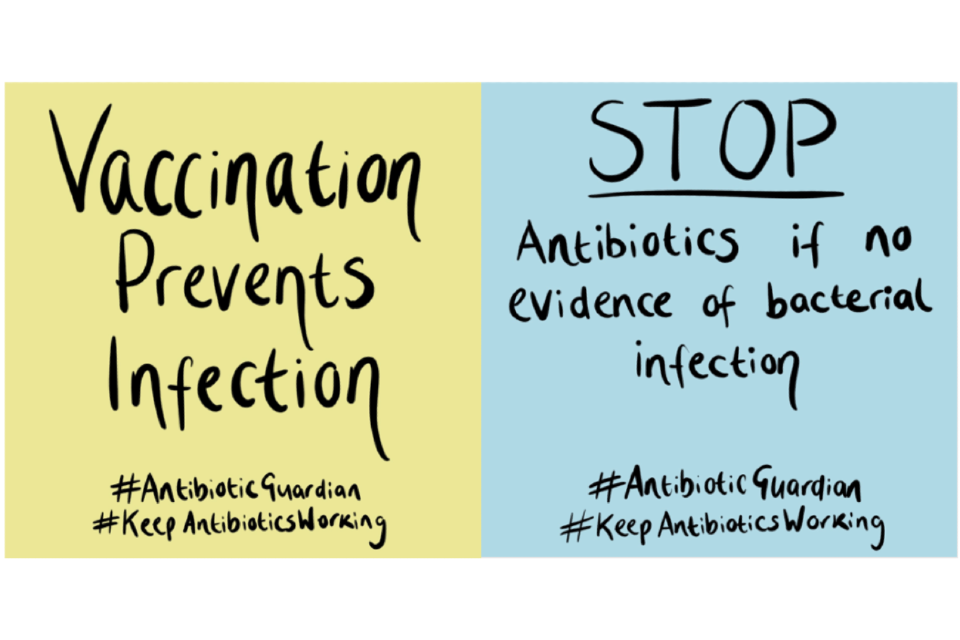
Figure 3 shows 2 digital ãsticky noteã style images ã one yellow on the left, and one blue on the right. The yellow digital note contains the text ãVaccination prevents infectionã while the blue note contains the text ãSTOP antibiotics if no evidence of bacterial infectionã. These messages are both followed by the hashtags #AntibioticGuardian and #KeepAntibioticsWorking.
A range ofä»ä»have also been designed, based on 5 core themes (Start smart then focus, Empiric prescribing, Course length, Patient safety and Resistance). Figure 4 shows examples of local messaging using ãdigital thank you notesã. These can be adapted for local messaging and include your organisations logo and areä» at . It is recommended to include images or figures to celebrate good practice within your organisation (for example a figure demonstrating reduced antibiotic prescribing in your local trust) to share with colleagues.
A range ofä»ä»ã produced by the Veterinary Medicines Directorate ã are also available for use. See Figure 5 for an example.
We encourage use of the message style that is most suited to your organisation. The format will allow adaptation for local messages.
Figure 4. Examples of the digital ãthank youã notes available for use duringä»WAAW
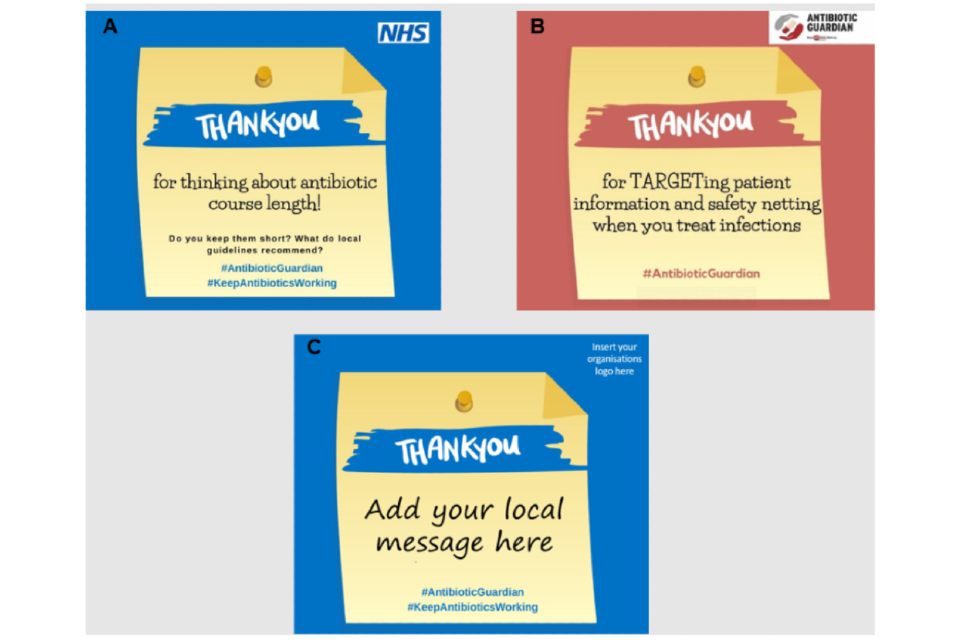
Figure 4 shows 3 examples of these digital notes, 2 with a blue background and one with a red background. Each image includes a yellow ãsticky noteã style image in the centre, upon which the word ãThankyouã is written in large text. Each note then follows with a specific message. The first blue note at the top left of the figure includes the NHS logo in the top right of the image. The red note at the top right of the figure includes the Antibiotic Guardian logo in the top right of the image. The blue images contain the hashtags #AntibioticGuardian and #KeepAntibioticsWorking at the bottom of the yellow sticky note and the red image contains just the #AntibioticGuardian. The blue image at the top left contains the message text ãfor thinking about antibiotic course length!ã after the large ãThankyouã text, whereas this is followed on the red image by the text ãfor TARGETing patient information and safety netting when you treat infectionsã. The blue image at the bottom centre of the figure contains free space underneath the ãThankyouã text for colleagues to enter their own message, as well as a space at the top right for colleagues to include their own logo.
Figure 5. An example of the Veterinary Medicine Directorate-produced One Health digital card, for use duringä»WAAW
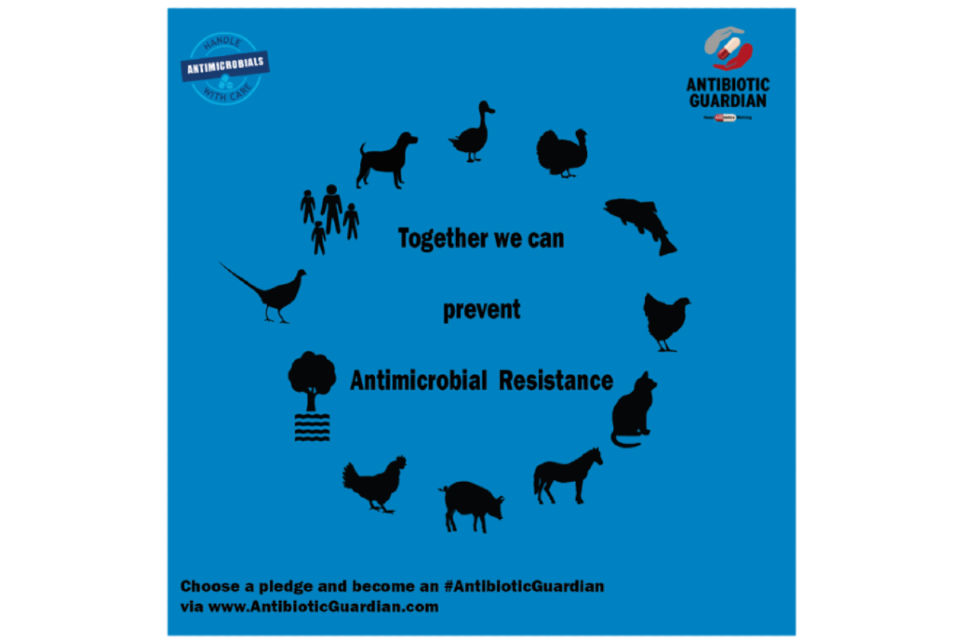
Figure 5 consists of a blue box for silhouette images of a range of animals, fish, humans, and trees arranged in a ring in the centre. Within this ring reads the text ãTogether we can prevent antimicrobial resistanceã. Text in the bottom left of the image reads ãChoose a pledge and become an #AntibioticGuardian viaä». The Antibiotic Guardian logo is included in the top right, with theä»WHOä»WAAWä»logo placed in the top left.
Guides for engaging with local communications team
Two quick guides have been produced to streamline local engagement with nationalä»WAAWä»initiatives. The first is a guide toä». Its purpose is to facilitate the collaboration of colleagues with their local communications professionals, to produce and release impactfulä»WAAWä»materials.
The second guide shows how to produce and share an organisationalä»WAAWä»video. We recommend that colleagues work with senior leaders, or within their own team to record and share a promotional video duringä»WAAW. We suggest the following video types, although you may wish to record other content ahead ofä»WAAW.
AMSä»pledge video
A short video from a senior leader to highlight the ongoing commitment to ã and importance of ã tacklingä»AMR.
Resource promotion video
A short video to highlight existingä»AMSä»resources and signpost to where users can find them.
ãMeet the teamã video
A short video to highlight current work in tacklingä»AMR, while showing the friendly faces of your organisation.
Thisä», which provides suggested wordings and examples from previous years, is available online and a preview can be seen in Figure 6. These organisational videos can be shared using the organisationãs social media channels, intranet and/or staff newsletters. Please use the following hashtags when sharing:
-
AntibioticGuardian
-
KeepAntibioticsWorking
-
WAAW2024
-
ConfrontingAMR
Figure 6. Screenshot of the quick guide to recording organisational videos forä»WAAW
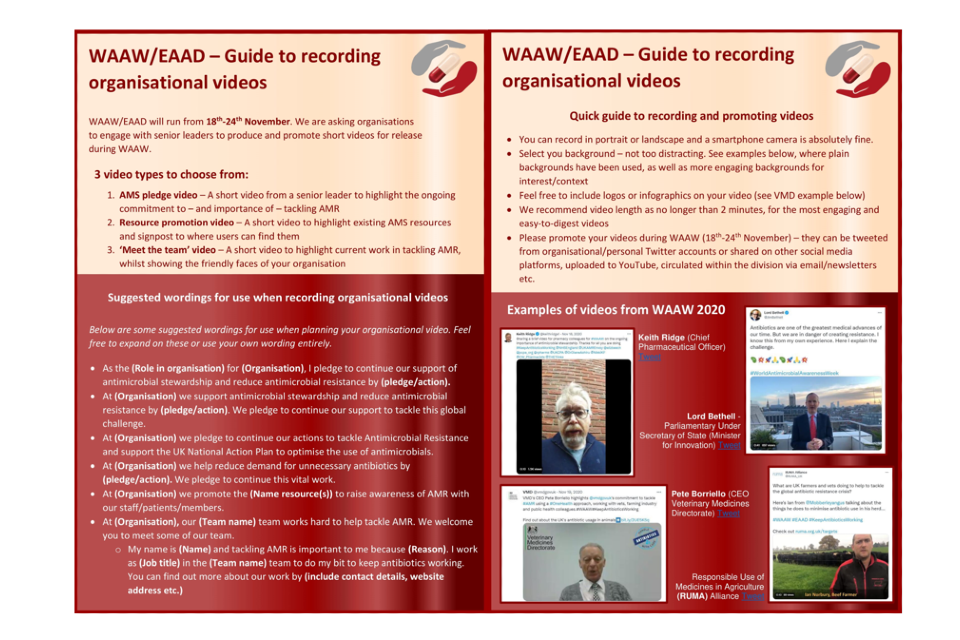
Figure 6 contains both pages of the quick guide shown side-by-side. Each page contains a 2-tone white and red background designed to align with the red and white pill motif used by Antibiotic Guardian and Keep Antibiotics Working campaigns.
The first page on the left of the figure contains 2 sections ã the first is an introduction followed by a summary of the 3 message types that colleagues can choose from when recording a video.
The second section contains suggested wording for colleagues to use when scripting their videos. On the second page ã on the right of the figure ã a further 2 sections are included. The first section provides a range of tips and suggestions for recording the videos. The second section contains examples of videos shared in 2020, with links to tweets and screenshots of the videos included.
A teleconference background has been developed for use duringä»WAAWä»and beyond. This has been developed to include key messages that align with theä»WAAWä»themes cited earlier in the toolkit. The ãred and white pillã design has been used for this background, to align with otherä»WAAWä»resources used in England, as well as the Antibiotic Guardian campaign. This background is designed to spark conversation when in virtual meetings.
Aä»ä»can be found online, alongside ãAntibiotic Guardianã and ãKeep Antibiotics Workingã general backgrounds, which can be used at any time.
A blue version of the teleconference background has been designed to align with the ãGo blue forä»AMRã day organised byä»WHO. For more information, seeä»Appendix 1. Aä»ä»can be found online.
Figure 7. Example of a teleconference background

This image contains a 2-tone white and red background designed to align with the red and white pill motif used by Antibiotic Guardian and Keep Antibiotics Working campaigns. The Antibiotic Guardian and Keep Antibiotics Working logos are included in the top left of the image. At the bottom left of the image, the text ãWorld Antimicrobial resistance Awareness Weekã is included in large black text, with the first letter of each word shown in larger lettering in red to highlight the abbreviation. This text is followed by ã18 to 24 Novemberã beneath it, to mark the date of the week. At the bottom right of the image, the text ãContact me to find out about resources available for tackling Antimicrobial Resistanceã is included in white. At the top right of the image, white text reading ãDonãt let antibiotics go viral. Cold, COVID-19 or flu? Then antibiotics wonãt help youã is included.
Theä»)ä»will be hosted byä»ä»social media accounts, and we encourage you to engage with and promote these polls duringä»WAAW.
There will be 5 polls with a different poll shared each weekday ofä»WAAWä»and the answers will be shared the following day. Theä».
Global X relay (formerly Global Twitter relay)
Join the 24-hour Global X relay in collaboration with US CDC,ä»ECDCä»and others on 18 November. The set time for the UK will be published closer to the date. Please continue to post on social media at any time but we encourage colleagues to post on X using theä»ä»at the start of the UK designated time, then your choice of additional messages for the rest of the hour. Seeä»Figure 8ä»for the Global X relay tweet card.
Global X relay message:
AntimicrobialResistance is one of the most urgent global threats to the publicãs health. Antibiotics can cause side-effects, including nausea and diarrhoea and contribute to the development of #AntibioticResistance #AntibioticGuardian #KeepAntibioticsWorking #WAAW
Thisä»X relay is anä»opportunity for colleagues to focusä»dissemination ofä»AMS-related messagesä»and/or relatedä»images on the X platform and other social media accounts.
To add an Xä»relay reminder to your Outlook calendar,ä»you canä».
In addition to the joint message and tweet card, there areä»ä»available for use.
Social media posts can be prepared ahead of time and set to be published at a pre-determined time, in case you are busy during the hour of the X UK relay. To schedule a post on the X app, click the calendar icon in the X post box once you have created your post to open the ãScheduleã box, you can then set the date and time that your tweet will be released, before clicking the ãConfirmã button. For more information, contact your local communications team.
Colleagues are encouraged to use the following hashtags when taking part in social media activity duringä»WAAW:
-
AntibioticGuardian
-
KeepAntibioticsWorking
-
WAAW2024
-
ConfrontingAMR
Figure 8. The X card available for use during the global X relay
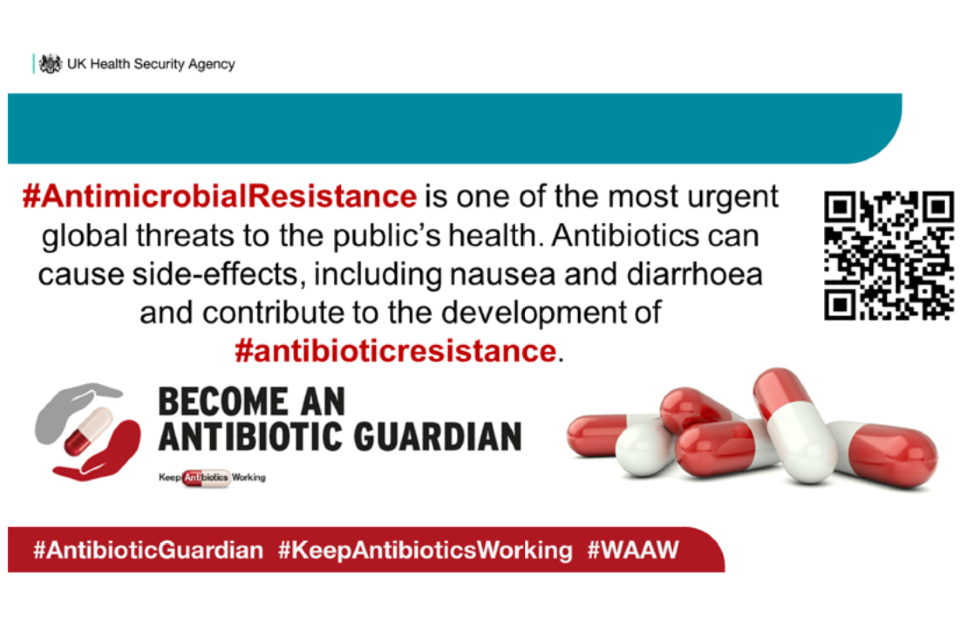
Figure 8 includes a logo forä»UKHSAä»at the top left and a logo for the ãAntibiotic Guardianã and ãKeep Antibiotics Workingã campaigns at the bottom left, above 3 hashtags in a maroon footer box (#AntibioticGuardian, #KeepAntibioticsWorking, #WAAW). An image of a pile of red and white antibiotic pills is placed next to the Antibiotic Guardian logo and a QR code for the Antibiotic Guardian website is placed above the pill image. To the left of the QR code reads the text ã#AntimicrobialResistance is one of the most urgent global threats to the publicãs health. Antibiotics can cause side-effects, including nausea and diarrhoea and contribute to the development of #antibioticresistanceã.
Resources for public awareness campaigns
Keep Antibiotics Working and Antibiotic Guardian campaigns
In 2014,ä»PHE developed the Antibiotic Guardian campaign and associated resources to provide educational resources to help tackleä»AMRä»in the UK. This was in collaboration with the Department of Health (now Department of Health and Social Care), Veterinary Medicines Directorate (VMD), the devolved administrations, local government, and professional organisations.
The impact and evaluation study of Antibiotic Guardian demonstrated that the campaign increased commitment to tacklingä»AMRä»in both healthcare professionals and members of the public, increased self-reported knowledge, and changed self-reported behaviour, particularly among people with priorä»AMRä»awareness.
ä»are available for use.
In 2017,ä»PHEä»launched a national campaign Keep Antibiotics Working (KAW) across England to support the governmentãs efforts to reduce inappropriate prescriptions for antibiotics by raising awareness of the issue of antibiotic resistance and reducing demand from the public using TV, radio, and social media.
KAWä»raises awareness of antibiotic resistance amongst the general public and encourages greater trust in the advice from healthcare professionals when it comes to whether consumers need antibiotics or not.
Although the campaign has not actively run on TV and radio since 2019, the are still current and available to download and use. The were translated into 12 additional languages in 2022. See Figure 9 for examples.
Figure 9. Three examples of a Keep Antibiotics Working campaign poster
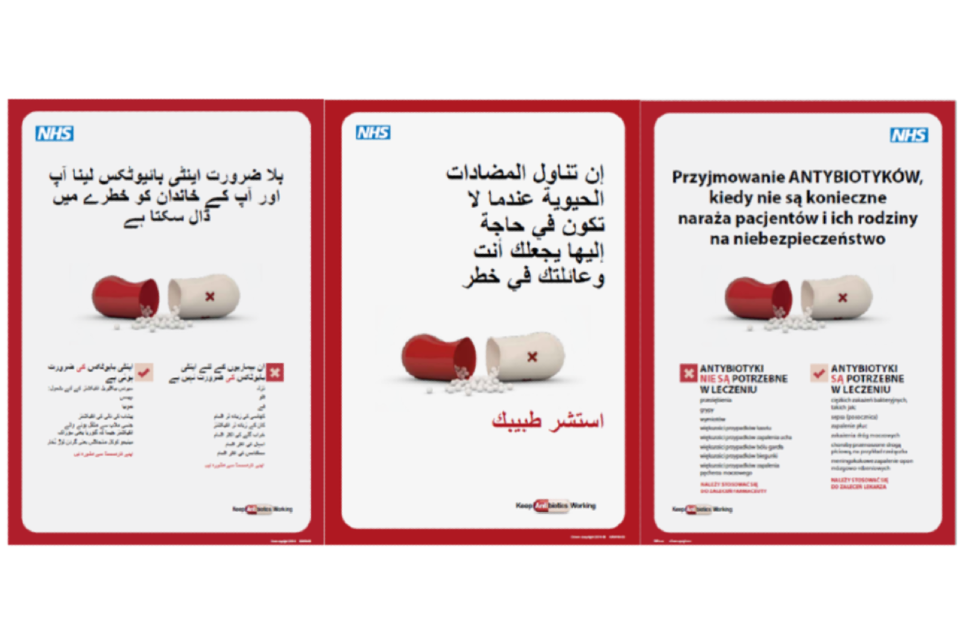
In Figure 9, from left to right, there are posters written in Urdu, Arabic and Polish. Each poster consists of a white background with a red border and an image of a red and white antibiotic pill, which has been split in half at the centre of the poster. An NHS logo is placed at the top left of the first 2 posters, and at the top right of the third. The ãKeep Antibiotics Workingã logo is placed at the bottom right of the first 2 posters, and at the bottom left of the third.
Chapter 6 Professional and public education, engagement, and training of the ESPAUR report shares some highlights of how to engage the public, sharing case studies as well as reviewing the success of the campaigns through data.
Antibiotic amnesty resources
Resources for organising aä»ä»are hosted on the Royal Pharmaceutical Society website. This initiative encourages individuals to safely dispose of unused or leftover antibiotics in collaboration with community pharmacies and veterinary practices.
Resources aimed at engaging with children and young people
e-Bug
Educational resources to run engaging activities and sessions on microbes, infection and antibiotics for ages 3 to 16. All activities and lesson plans are designed to complement the National Curriculum and can be adapted to meet the needs of your group.
Antibiotic Guardian Schools Ambassadors
Through the Antibiotic Guardian Schools Ambassadors programme, public health and healthcare professionals, vets, vet nurses and scientists are invited to connect with local schools and community groups. ä»Ambassadors are encouraged to provide a teaching session, promote a toolkit of lesson planning resources, and/or provide an article on important public health topics such as microbes, hygiene, infection prevention and antibiotics for schools to include in their newsletter.
Further information on the programme and registration is available on the . The toolkit and newsletter item resources will be provided automatically to those that register to become an AG Schools Ambassador.
Additionalä»AMRä»resources, toolkits and wider activity
Toolkits and resources
Previous versions ofä»WAAWä»orä»EAADä»toolkits
WAAWä»orä»EAADä»toolkit, including versions from previous yearsä»are available online.
Quizzes and crosswords
You can have a virtual competition or shareä»quizzes and crosswordsä»via your organisation or school newsletter.
AMSä»game
Theä»ä»is an educational game for healthcare professionals, this exploresä»AMSä»ý¿ýå£Íä»AMR; it is available as a face-to-face (board game) and online versions. The 4 broad areas addressed in the game are:
- introduction toä»AMRä»and stewardship
- appropriate use of antimicrobial agents
- infection prevention and control
- stewardship and surveillance
The game can be played by all members of staff, including:
- doctors
- nurses
- pharmacy teams
- veterinary teams
- laboratory staff
- other clinical staff
- support staff
- cleaners and porters
- students
ä»ã which was co-created by a multidisciplinary team of health professionals spanning across high- and low-to middle-income countries ã is available online.
Figure 10. AMSä»game in both physical and virtual format
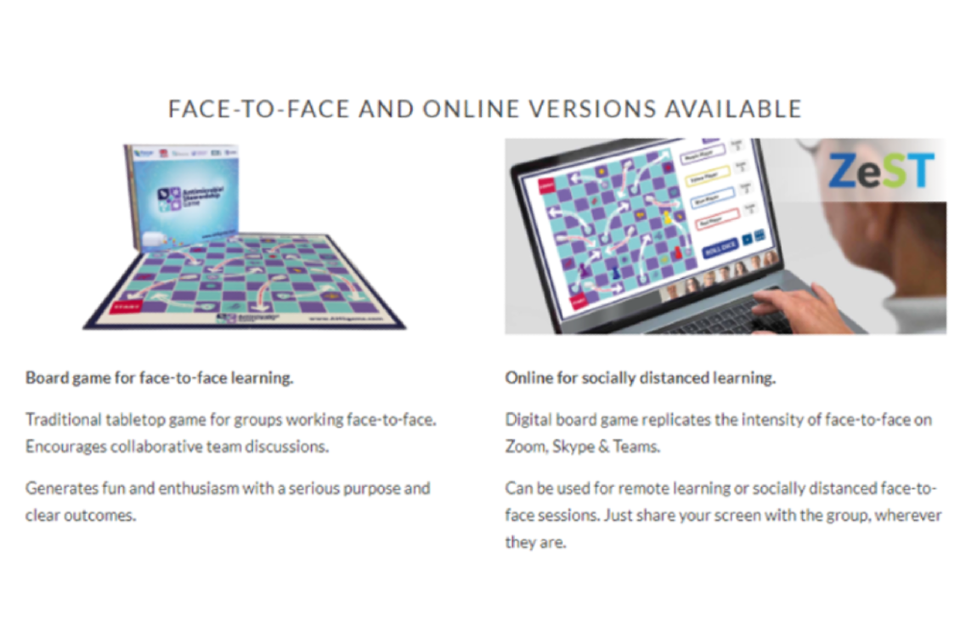
Figure 10. is split into 2 images. The image on the left shows a physical version of the boardgame, which sits in front of its box. On the right, there is an image of an individual using a laptop, with an online version of the game on the screen. In both images, the game takes the form of a 10 by 10 grid board, with alternating blue and purple squares.
Posters and leaflets
Posters and leafletsä»are available for the public and healthcare professionals to support antibiotic awareness campaigns in the UK.
Patient story videos
ä»can be shared as part ofä»WAAWä»campaigns. There are a range available via , and websites
ãStart smart then focusã toolkit
Start smart then focusä»(SSTF) is a toolkit of evidence-basedä»AMSä»resources for the secondary healthcare setting. The competencies and algorithms were updated using a stepwise and systematic approach and were subsequently published on 12 September 2023.
It is recommended that healthcare organisations should monitor adherence to theä»SSTFä»principles regularly in all clinical areas (at least annually) and, in England, evidence adherence to the Code of Practice, developing an action plan for improvement as required.
Secondary care prescriberãs checklist
Prescribers in secondary healthcare can use theä»prescribing antimicrobials checklistä»to help make decisions about prescribing antibiotics. This checklist was updated in September 2023, and is an updated version of the resource previously published in theä»SSTFä»toolkit.
IV to oral switch criteria
IV to oral switch criteriaä»for adults, children and young people, are available to support early switching from intravenous to oral antibiotics, co-produced through a UK-wide consensus process.
Antibiotic Review Kit
Theä»ä»holds a range of resources designed to help all healthcare professionals to reduce antibiotic overuse in hospitals.
Dental toolkit
Theä»dentalä»AMSä»toolkitä»helps primary care practitioners promote the appropriate use of antibiotics in dental care.
Antimicrobial and prescribing stewardship competencies
Theä»antimicrobial and prescribing stewardship competenciesä»for all independent prescribers to help improve the quality of prescribing practice are available on äšûâƯå¤. Theä»antimicrobial prescribing and stewardship competency frameworkä»was updated and published in August 2023.
Wider activities and resources
European Centre for Disease Prevention and Control resources:
, particularly on 24 November. This can be supported through online presence, physical communities, and workplaces. Find out more inä»Appendix 1.
Infection Prevention Societyãsä».
WAAWä»orä»EAADä»national planning group
The nationalä»WAAWä»or EEAD planning group meets biannually to discuss national plans forä»WAAWä»orä»EAADä»and share learning. The group is chaired by Dr Diane Ashiru-Oredope,ä»UKHSA.
The planning group had representation from:
- all UK nations
- UKHSAä»teams (includingä»AMRä»Programme Board, e-Bug, TARGET, Behavioural Insights)
- NHS England
- British Society for Antimicrobial Chemotherapy (BSAC)
- Centre for Postgraduate Pharmacy Education (CPPE)
- Royal Pharmaceutical Society (RPS)
- Veterinary Medicines Directorate, Department for Environment, Food and Rural Affairs (DEFRA)
- National Institute for Health and Care Excellence (NICE)
- British Dental Association (BDA)
- Leeds GP Confederation
- Regional Antimicrobial Pharmacists Network
The resources forä»WAAWä»are developed through a multidisciplinary subgroup which has been led by Dr Louise Dunsmure (2020), Fran Garraghan (2021 and 2022) and, in 2023 to 2024, Rakhi Aggarwal.
Appendix.ä»WHOä»WAAWä»campaign
World Health Organizationãs (WHOãs) theme for the World AMR Awareness Week (WAAW) 2024 is ãEducate. Advocate. Act nowã. This theme was chosen based on feedback from an online survey among stakeholders from the human, animal, plant, and environmental health sectors, which collected nearly 200 responses globally.
The slogan ofä»WAAWä»remains ãAntimicrobials: Handle with Careã.ä»ä»are available from their campaign website. Launched in May 2024, the World Health Organizationãs campaign puts advocates front and centre to share their stories, raise awareness and urge action to address AMR.
The 2024 UN General Assembly High-level Meeting on AMR and the fourth Global High-Level Ministerial Conference on AMR, for instance, provide a critical window of opportunity for political and financial commitments as well as increased accountability in response to AMR. Stronger political leadership, advocacy and accountability are needed at all levels and the time to act is now.
WHOä»is encouraging the global community to ãGo blue forä»AMRã, particularly on 24 November. This can be supported through online presence, physical communities and workplaces.ä», including a toolkit, can be found online. Anä»ä»designed to align with the ãGo blue forä»AMRã day is shown in Figure 11. An example of ãGo blue forä»AMRã activities being advocated on social media is shown in Figure 12.
Ways to join the campaign
Individuals can:
- wear light blue when participating inä»WAAWä»events
- adjust your social media profiles to blue
- share why you are ãGoing blueã with friends, family, colleagues, and on social media (for example, ãIãm Going blue in honour of my uncle, who contracted a drug-resistant infection following hip surgeryã or ãAs a doctor, Iãm ãGoing blueã to spread awareness among my colleagues about responsible antimicrobial prescribingã)
Workplaces or organisations can:
- light up one health stakeholder facilities (human and animal hospitals, clinics, laboratory facilities, pharmaceutical headquarters, universities) in blue
- combine this with workplace actions: create or reviewä»AMSä»programmes, educate staff onä»AMRä»and make a workplace commitment toä»AMR-related change
- share with the world ã use social or traditional media to announce why your workplace staff are going blue
Figure 11. Example of a teleconference background adapted for use duringä»WAAWä»as part of theä»WHOä»ãGo blue forä»AMRã day on the 24 November.

Figure 11 contains a 2-tone white and blue background. The Antibiotic Guardian and Keep Antibiotics Working logos are included in the top centre of the image with theä»WHOä»ãAntimicrobial ã Handle with careã logo below it. To the left of these 2 logos, text ãWorld Antimicrobial resistance Awareness Weekã is included in large black text, with the first letter of each word shown in larger lettering in blue to highlight the abbreviation. This text is followed by ã18 to 24 Novemberã beneath it ã in blue ã to mark the date of the week. To the right of the logos in the centre top of the image is the text ãGo blue forä»AMR. Contact me to find out about resources available for tackling Antimicrobial Resistanceã. The first sentence is in dark blue, with the subsequent wording in lighter blue.
Figure 12. Examples of social media posts forä»WAAWä»ý¿ýå£Íä»EAADä»2022
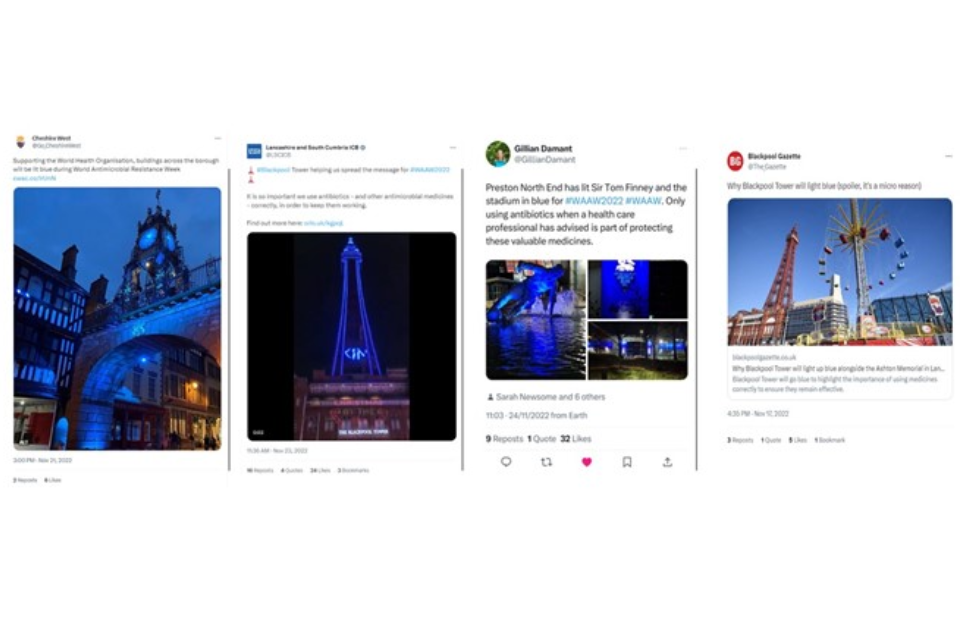
Figure 12 shows a collage of 4 screenshots of former Twitter posts sitting side by side. Far left screenshot posted by Cheshire West of a bridge and clocktower in the background lit blue. Middle left screenshot posted by Lancashire and South Cumbria ICB is of Blackpool tower, a tall structure, lit up blue at nighttime, with a building visible in the foreground. Middle right screenshot posted by Gill Damant with 3 thumbnail images below some text, on the left a picture of a statue of Sir Tom Finney kicking a football over some water with a fountain in the background which are lit blue for Go Blue campaign. To the top right of this image is a smaller thumbnail of Preston North End Football Club stadium lit up in blue, below this is image on the bottom right is a wider angle shot of the same stadium lit up in blue lights with some trees and grass verge in the foreground. The far-right image is a screenshot of a post by Blackpool Gazette with Blackpool tower in the background during the daytime and a fairground ride in the foreground, with the text ãWhy Blackpool tower will light blue (spoiler, itãs a micro reason)ã.
Public feedback on Go Blue campaign
Research was conducted by the international insight consultancy, Basis, to determine the awareness and impact of supportingä»WHOãs ãGo blue forä»AMRã campaign. The research focused on the local area of Blackpool to understand the reaction to local activity, including lighting up Blackpool Tower.
This research highlighted the importance of clear, impactful messaging for this campaign. A high number of people interviewed (94%) were aware of the tower being lit blue before they were interviewed, however the majority (64%) did not see any messages, and 3% of those interviewed thought the messages said ãkeep antibiotics workingã.
Although 93% of those interviewed had an understanding of antibiotic usage, such as never sharing antibiotics with anyone else, around one in 5 had never heard ofä»WAAWä»week.
Therefore, we encourage that throughout the Go Blue activities, to ensure that there are clear messages highlighting the reasons behind this, to ensure maximum impact on driving the key message and overall awareness ofä»WAAW.
Emailä»ESPAUR@ukhsa.gov.ukä»for more information on how we can help you with the Go Blue campaign.
